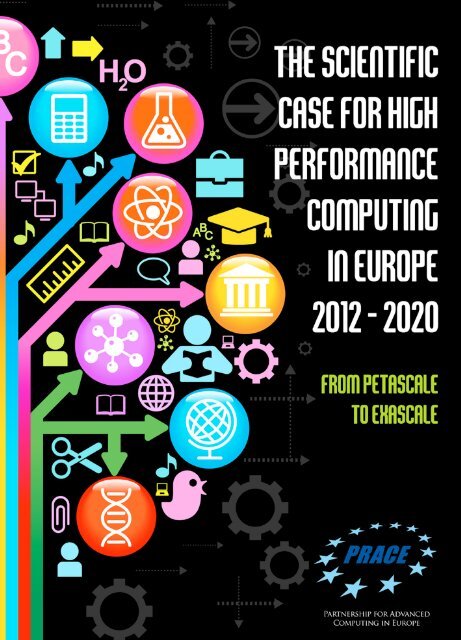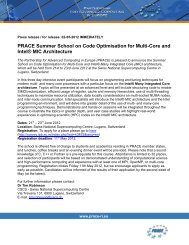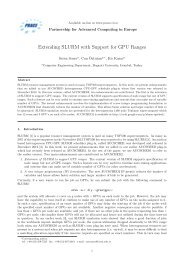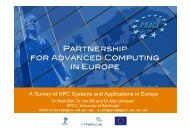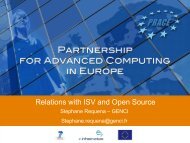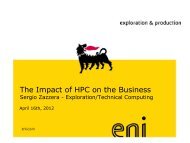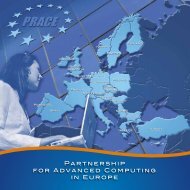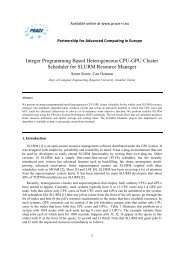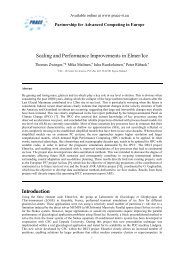The Scientific Case for HPC in Europe - prace
The Scientific Case for HPC in Europe - prace
The Scientific Case for HPC in Europe - prace
Create successful ePaper yourself
Turn your PDF publications into a flip-book with our unique Google optimized e-Paper software.
PRACE, October 2012<br />
Copyright notice<br />
ALL RIGHTS RESERVED. This report conta<strong>in</strong>s material protected under<br />
International and Federal Copyright Laws and Treaties. Any unauthorized<br />
repr<strong>in</strong>t or use of this material is prohibited. No part of this report may<br />
be reproduced or transmitted <strong>in</strong> any <strong>for</strong>m or by any means, electronic<br />
or mechanical, <strong>in</strong>clud<strong>in</strong>g photocopy<strong>in</strong>g, record<strong>in</strong>g, or by any <strong>in</strong><strong>for</strong>mation<br />
storage and retrieval system without express written permission from the<br />
author / publisher.<br />
<strong>The</strong> copyrights of the content and images conta<strong>in</strong>ed with<strong>in</strong> this report<br />
rema<strong>in</strong> with their orig<strong>in</strong>al owner(s). <strong>The</strong> PRACE name and the PRACE<br />
logo are © PRACE.<br />
All diagrams and most photographs are orig<strong>in</strong>al to this book. See<br />
copyright notice <strong>for</strong> <strong>in</strong>dividual copyrights.<br />
Pr<strong>in</strong>ted by Bishops Pr<strong>in</strong>ters Ltd, Spa House, Walton Road, Portsmouth,<br />
Hampshire, PO6 1TR, United K<strong>in</strong>gdom, Telephone +44 239 2334 900<br />
Published by Insight Publishers Ltd, 12-13 K<strong>in</strong>g Square, Bristol, BS2 8JH,<br />
Telephone +44 117 2033 120, www.ipl.eu.com<br />
Project Manager<br />
Ellen Haggan<br />
Designer<br />
Mike Staf<strong>for</strong>d<br />
Additional designers<br />
Thomas Hunt<br />
Layout assistant<br />
Simon Browne<br />
Proofreader<br />
Becky Freeman<br />
Pr<strong>in</strong>t manager<br />
Paul Rumbold<br />
PRACE<br />
<strong>The</strong> PRACE Research Infrastructure is established as an <strong>in</strong>ternational<br />
non-profit association with seat <strong>in</strong> Brussels and is named “Partnership <strong>for</strong><br />
Advanced Comput<strong>in</strong>g <strong>in</strong> <strong>Europe</strong> aisbl”. It has 24 member countries (June<br />
2012) whose representative organisations are creat<strong>in</strong>g a pan-<strong>Europe</strong>an<br />
supercomput<strong>in</strong>g <strong>in</strong>frastructure, provid<strong>in</strong>g access to comput<strong>in</strong>g and<br />
data management resources and services <strong>for</strong> large-scale scientific and<br />
eng<strong>in</strong>eer<strong>in</strong>g applications at the highest per<strong>for</strong>mance level.<br />
www.<strong>prace</strong>-ri.eu<br />
This work has received fund<strong>in</strong>g from the <strong>Europe</strong>an Community’s Seventh<br />
Framework Programme (FP7/2007-2013) <strong>in</strong> the PRACE-1IP Project under<br />
grant agreement n° RI-261557.<br />
Lead Author<br />
Martyn Guest – Cardiff<br />
University, UK<br />
Secretary<br />
Giovanni Erbacci – PRACE-1IP<br />
WP4 leader<br />
Editor-<strong>in</strong>-chief<br />
Marjole<strong>in</strong> Oorsprong – PRACE<br />
Communications Officer<br />
Panel Chairs<br />
Giovanni Aloisio – University of<br />
Salento and ENES-CMCC, Italy<br />
Stefan Blügel – Forschungszentrum<br />
Jülich, Germany<br />
Modesto Orozco – Institute <strong>for</strong><br />
Research <strong>in</strong> Biomedic<strong>in</strong>e, Spa<strong>in</strong><br />
Philippe Ricoux – TOTAL, France<br />
Andreas Schäfer – University of<br />
Regensburg, Germany<br />
<strong>Scientific</strong> <strong>Case</strong><br />
Management Group<br />
Turlough Downes – PRACE User<br />
Forum (Chair)<br />
Richard Kenway – PRACE <strong>Scientific</strong><br />
Steer<strong>in</strong>g Committee (Chair)<br />
Thomas Lippert – PRACE-1IP<br />
Project Coord<strong>in</strong>ator<br />
Maria Ramalho – PRACE aisbl<br />
Act<strong>in</strong>g Manag<strong>in</strong>g Director
Executive Summary<br />
PRACE – <strong>The</strong> <strong>Scientific</strong> <strong>Case</strong> <strong>for</strong> <strong>HPC</strong> <strong>in</strong> <strong>Europe</strong><br />
1In 2005 and 2006, an <strong>in</strong>ternational panel<br />
produced a White Paper entitled ‘<strong>Scientific</strong><br />
<strong>Case</strong> <strong>for</strong> Advanced Comput<strong>in</strong>g <strong>in</strong> <strong>Europe</strong>’ that<br />
argued the case <strong>for</strong> High-Per<strong>for</strong>mance Comput<strong>in</strong>g<br />
(<strong>HPC</strong>) to support <strong>Europe</strong>an competitiveness. <strong>The</strong><br />
document was published by the ‘<strong>HPC</strong> <strong>in</strong> <strong>Europe</strong><br />
Task<strong>for</strong>ce’ <strong>in</strong> January 2007. <strong>The</strong> <strong>in</strong>itiative was<br />
<strong>in</strong>strumental to the establishment of PRACE – <strong>The</strong><br />
Partnership <strong>for</strong> Advanced Comput<strong>in</strong>g <strong>in</strong> <strong>Europe</strong><br />
– and the PRACE Research Infrastructure (PRACE-<br />
RI) <strong>in</strong> April 2010. This document represents the<br />
culm<strong>in</strong>ation of an <strong>in</strong>itiative by PRACE to create<br />
an update of the <strong>Scientific</strong> <strong>Case</strong> and capture the<br />
current and expected future needs of the scientific<br />
communities. It has <strong>in</strong>volved the PRACE <strong>Scientific</strong><br />
Steer<strong>in</strong>g Committee (SSC), lead<strong>in</strong>g scientists from<br />
across all major user discipl<strong>in</strong>es, and has been<br />
funded through the 1st Implementation Phase of<br />
PRACE – the PRACE-1IP project.<br />
2Five years after the publication of the<br />
scientific case, the <strong>HPC</strong> landscape <strong>in</strong> <strong>Europe</strong><br />
has changed significantly. <strong>The</strong> PRACE<br />
Research Infrastructure is provid<strong>in</strong>g Tier-0 <strong>HPC</strong><br />
services – large allocations of time on some of<br />
the most powerful computers <strong>in</strong> the world – to<br />
researchers <strong>in</strong> <strong>Europe</strong>, a global ef<strong>for</strong>t has been<br />
launched towards achiev<strong>in</strong>g exascale <strong>HPC</strong> by the<br />
end of this decade, and the importance of <strong>HPC</strong><br />
<strong>in</strong> solv<strong>in</strong>g the socio-economic challenges and<br />
ma<strong>in</strong>ta<strong>in</strong><strong>in</strong>g <strong>Europe</strong>’s competitiveness has become<br />
even more evident.<br />
Communication<br />
from the EC<br />
‘High-Per<strong>for</strong>mance Comput<strong>in</strong>g: <strong>Europe</strong>’s<br />
place <strong>in</strong> a Global Race’ COM (2012)<br />
45 F<strong>in</strong>al. Brussels 15.02.2012<br />
‘<strong>The</strong> race <strong>for</strong> leadership <strong>in</strong> <strong>HPC</strong> systems is<br />
driven both by the need to address societal and<br />
scientific grand challenges more effectively, such<br />
as early detection and treatment of diseases<br />
like Alzheimer’s, decipher<strong>in</strong>g the human bra<strong>in</strong>,<br />
<strong>for</strong>ecast<strong>in</strong>g climate evolution, or prevent<strong>in</strong>g and<br />
manag<strong>in</strong>g large-scale catastrophes, and by the<br />
needs of <strong>in</strong>dustry to <strong>in</strong>novate <strong>in</strong> products and<br />
services.’<br />
‘Industry has a dual role <strong>in</strong> high-end comput<strong>in</strong>g:<br />
firstly, supply<strong>in</strong>g systems, technologies and<br />
software services <strong>for</strong> <strong>HPC</strong>; and secondly, us<strong>in</strong>g<br />
<strong>HPC</strong> to <strong>in</strong>novate <strong>in</strong> products, processes and<br />
services. Both are important <strong>in</strong> mak<strong>in</strong>g <strong>Europe</strong><br />
more competitive. Especially <strong>for</strong> SMEs, access to<br />
<strong>HPC</strong>, modell<strong>in</strong>g, simulation, product prototyp<strong>in</strong>g<br />
services and consult<strong>in</strong>g is important to rema<strong>in</strong><br />
competitive. This Action Plan advocates <strong>for</strong> a<br />
dual approach: strengthen<strong>in</strong>g both the <strong>in</strong>dustrial<br />
demand and supply of <strong>HPC</strong>.’<br />
3 4<br />
<strong>The</strong> scope of this report is wide-rang<strong>in</strong>g<br />
and captures the conclusions of five<br />
scientific areas, each derived from the work<br />
of an associated panel of experts. <strong>The</strong> five panels<br />
<strong>in</strong>clude those <strong>in</strong> the areas of: Weather, Climatology<br />
and solid Earth Sciences; Astrophysics, HEP and<br />
Plasma Physics; Materials Science, Chemistry and<br />
Nanoscience; Life Sciences and Medic<strong>in</strong>e; and<br />
Eng<strong>in</strong>eer<strong>in</strong>g Sciences and Industrial Applications.<br />
<strong>The</strong> position of <strong>HPC</strong> has evolved s<strong>in</strong>ce 2007<br />
from a technology crucial to the academic<br />
research community to a po<strong>in</strong>t where it<br />
is acknowledged as central <strong>in</strong> pursu<strong>in</strong>g ‘<strong>Europe</strong>’s<br />
place <strong>in</strong> a Global Race’. <strong>The</strong> extract from the<br />
communication from the Commission to the<br />
<strong>Europe</strong>an Parliament, <strong>in</strong> the panel, above, pays<br />
testimony to this position.<br />
3
PRACE – <strong>The</strong> <strong>Scientific</strong> <strong>Case</strong> <strong>for</strong> <strong>HPC</strong> <strong>in</strong> <strong>Europe</strong><br />
5<strong>HPC</strong> is currently undergo<strong>in</strong>g a major change as the next generation of comput<strong>in</strong>g systems<br />
(‘exascale systems’) is be<strong>in</strong>g developed <strong>for</strong> 2020. <strong>The</strong>se new systems pose numerous challenges,<br />
from a 100-fold reduction of energy consumption to the development of programm<strong>in</strong>g models<br />
<strong>for</strong> computers that host millions of comput<strong>in</strong>g elements, while address<strong>in</strong>g the data challenge presented<br />
by the storage and <strong>in</strong>tegration of both observational and simulation/modell<strong>in</strong>g data. <strong>The</strong>se challenges<br />
cannot be met by mere extrapolation but require radical <strong>in</strong>novation <strong>in</strong> several comput<strong>in</strong>g technologies.<br />
This offers opportunities to <strong>in</strong>dustrial and academic players <strong>in</strong> the EU to reposition themselves <strong>in</strong> the field.<br />
6All of the panels contribut<strong>in</strong>g to this report are conv<strong>in</strong>ced that the competitiveness of <strong>Europe</strong>an<br />
science and <strong>in</strong>dustry will be jeopardised if sufficiently capable computers are not made available,<br />
together with the associated <strong>in</strong>frastructure and skilled people necessary to maximise their<br />
exploitation. <strong>The</strong> panels have listed multiple areas at risk <strong>in</strong> conclud<strong>in</strong>g that access to high-per<strong>for</strong>mance<br />
computers <strong>in</strong> the exascale range is of the utmost importance. Thus, <strong>in</strong> aerospace, considerable changes<br />
<strong>in</strong> the development processes will lead to a significant reduction <strong>in</strong> development times while at the same<br />
time <strong>in</strong>clud<strong>in</strong>g more and more discipl<strong>in</strong>es <strong>in</strong> the early design phases to f<strong>in</strong>d an overall optimum <strong>for</strong> the<br />
aircraft configuration. This will enable the <strong>Europe</strong>an aircraft <strong>in</strong>dustry to keep a lead<strong>in</strong>g role <strong>in</strong> worldwide<br />
competition, fac<strong>in</strong>g both an old challenge, i.e. compet<strong>in</strong>g with the USA, and a new, rapidly emerg<strong>in</strong>g one –<br />
keep<strong>in</strong>g an <strong>in</strong>novation advantage over Ch<strong>in</strong>a. However, while aerospace can af<strong>for</strong>d its own <strong>HPC</strong> provision, it<br />
may not have the capability to exploit exascale if similar systems are not available to academia <strong>for</strong> tra<strong>in</strong><strong>in</strong>g<br />
and software development. In a similar ve<strong>in</strong>, the lack of high-per<strong>for</strong>mance computers appropriate <strong>for</strong> life<br />
sciences research will displace R&D activities to the USA, Ch<strong>in</strong>a or Japan, putt<strong>in</strong>g <strong>Europe</strong>an leadership <strong>in</strong> this<br />
field at risk.<br />
7Provid<strong>in</strong>g scientists and eng<strong>in</strong>eers with ongo<strong>in</strong>g access to computers of leadership class must<br />
be recognised as an essential strategic priority <strong>in</strong> <strong>Europe</strong>: there is a compell<strong>in</strong>g need <strong>for</strong> a<br />
cont<strong>in</strong>ued <strong>Europe</strong>an commitment to exploit the most powerful computers. Such resources are<br />
likely to rema<strong>in</strong> extremely expensive and require significant expertise to procure, deploy and utilise<br />
efficiently; some fields even require research <strong>for</strong> specialised and optimised hardware. <strong>The</strong> panel<br />
stresses that these resources should cont<strong>in</strong>ue to be reserved <strong>for</strong> the most exigent computational tasks<br />
of high potential value. It is clear that the computational resource pyramid must rema<strong>in</strong> persistent<br />
and compell<strong>in</strong>g at all levels, <strong>in</strong>clud<strong>in</strong>g national centres, access and data grids. <strong>The</strong> active <strong>in</strong>volvement<br />
of the <strong>Europe</strong>an Community along with appropriate member states rema<strong>in</strong>s critical <strong>in</strong> ma<strong>in</strong>ta<strong>in</strong><strong>in</strong>g a<br />
world-lead<strong>in</strong>g supercomputer <strong>in</strong>frastructure <strong>in</strong> the <strong>Europe</strong>an ecosystem. <strong>Europe</strong> must foster excellence<br />
and cooperation <strong>in</strong> order to ga<strong>in</strong> the full benefits of exascale comput<strong>in</strong>g <strong>for</strong> science, eng<strong>in</strong>eer<strong>in</strong>g and<br />
<strong>in</strong>dustry <strong>in</strong> the <strong>Europe</strong>an Research Area.<br />
Provid<strong>in</strong>g scientists and eng<strong>in</strong>eers with ongo<strong>in</strong>g access to<br />
computers of leadership class must be recognised as an<br />
essential strategic priority <strong>in</strong> <strong>Europe</strong>: there is a compell<strong>in</strong>g<br />
need <strong>for</strong> a cont<strong>in</strong>ued <strong>Europe</strong>an commitment to exploit the<br />
‘most powerful computers.<br />
4<br />
‘
Key statements<br />
PRACE – <strong>The</strong> <strong>Scientific</strong> <strong>Case</strong> <strong>for</strong> <strong>HPC</strong> <strong>in</strong> <strong>Europe</strong><br />
By way of summary, we present below key statements from the<br />
Commission and from our thematic panels that emphasise the<br />
essential role of a susta<strong>in</strong>able top-level <strong>in</strong>frastructure<br />
‘High-Per<strong>for</strong>mance<br />
Comput<strong>in</strong>g (<strong>HPC</strong>) is<br />
critical <strong>for</strong> <strong>in</strong>dustries<br />
that rely on precision and<br />
speed, such as automotive<br />
and aviation, and the<br />
health sector. Access to<br />
rapid simulations carried<br />
out by ever-improv<strong>in</strong>g<br />
supercomputers can be<br />
the difference between<br />
life and death; between<br />
new jobs and profits or<br />
bankruptcy.’<br />
Communication from the<br />
EC: ‘High-Per<strong>for</strong>mance<br />
Comput<strong>in</strong>g: <strong>Europe</strong>’s place <strong>in</strong><br />
a Global Race’ COM (2012) 45<br />
F<strong>in</strong>al. Brussels 15.02.2012<br />
Weather, Climatology and solid Earth Sciences (WCES)<br />
“In the last decade, our understand<strong>in</strong>g of Climate<br />
Change has <strong>in</strong>creased, as has the societal need <strong>for</strong><br />
pull through to advice and policy. However, whilst<br />
there is great confidence <strong>in</strong> the fact that climate<br />
change is happen<strong>in</strong>g, there rema<strong>in</strong> uncerta<strong>in</strong>ties.<br />
While there is uncerta<strong>in</strong>ty about the levels of<br />
greenhouse gas emissions and aerosols likely to<br />
be emitted, there are perhaps more significantly<br />
uncerta<strong>in</strong>ties on the degree of warm<strong>in</strong>g and<br />
the likely impacts. Increas<strong>in</strong>g the capability and<br />
comprehensiveness of ‘whole Earth system’ models<br />
that represent <strong>in</strong> ever-<strong>in</strong>creas<strong>in</strong>g realism and detail,<br />
scenarios <strong>for</strong> our future climate is the only way to<br />
reduce these latter uncerta<strong>in</strong>ties.”<br />
“A programme of provision of Leadership-class<br />
computational resources will make it <strong>in</strong>creas<strong>in</strong>gly<br />
possible <strong>in</strong> solid Earth Sciences to address<br />
the issues of resolution, complexity, duration,<br />
confidence and certa<strong>in</strong>ty. Challenges have<br />
significant scientific and social implications, play<strong>in</strong>g<br />
today a central role <strong>in</strong> natural hazard mitigation,<br />
treaty verification <strong>for</strong> nuclear weapons, and<br />
<strong>in</strong>creased discovery of economically recoverable<br />
petroleum resources and monitor<strong>in</strong>g of waste<br />
disposal.”<br />
“<strong>The</strong>re is a fundamental need <strong>in</strong> Oceanography<br />
and Mar<strong>in</strong>e Forecast<strong>in</strong>g to build and efficiently<br />
operate the most accurate ocean models.<br />
Improved understand<strong>in</strong>g of ocean circulation<br />
and biogeochemistry is critical to assess properly<br />
climate variability and future climate change and<br />
related impacts on e.g. ocean acidification, coastal<br />
sea level, mar<strong>in</strong>e life, polar sea-ice cover, etc.”<br />
5
PRACE – <strong>The</strong> <strong>Scientific</strong> <strong>Case</strong> <strong>for</strong> <strong>HPC</strong> <strong>in</strong> <strong>Europe</strong><br />
Astrophysics, High-Energy Physics and Plasma Physics<br />
“Astrophysics, high-energy physics and<br />
plasma physics have, <strong>in</strong> recent years, shared<br />
a dramatic change <strong>in</strong> the role of theory <strong>for</strong><br />
scientific discovery. In all three fields, new<br />
experiments become ever more costly, require<br />
<strong>in</strong>creas<strong>in</strong>gly long time scales and aim at the<br />
<strong>in</strong>vestigation of more and more subtle effects.<br />
Consequently, theory is faced with two types<br />
of demands: Precision of theory predictions<br />
has to be <strong>in</strong>creased to the po<strong>in</strong>t that it is<br />
better than the experimental one. This is a<br />
most demand<strong>in</strong>g requirement as the latter can<br />
be expected to <strong>in</strong>crease by further orders of magnitude until 2020. In parallel, the need to explore model<br />
spaces of much larger extent than previously <strong>in</strong>vestigated also became apparent. For example:<br />
• In astrophysics determ<strong>in</strong>ation of the nature of dark energy and dark matter requires a detailed<br />
comparison of predictions from large classes of cosmological models with data from the new satellites<br />
and ground based detectors which will be deployed until 2020.<br />
• In high-energy physics, one of the tasks is to explore many possible extensions of the Standard Model to<br />
such a degree, that even m<strong>in</strong>ute deviations between experimental data and Standard Model predictions<br />
can serve as smok<strong>in</strong>g guns <strong>for</strong> a specific realization of New Physics.<br />
• In plasma physics, one of the tasks is to understand the physics observed at ITER at such a high level<br />
that substantially more efficient fusion reactors could be reliably designed based on theoretical<br />
simulations which explore a large range of options.”<br />
Materials Science, Chemistry and Nanoscience<br />
“Computational materials science, chemistry and<br />
nanoscience is concerned with the complex <strong>in</strong>terplay<br />
of the myriads of atoms <strong>in</strong> a solid or a liquid, thereby<br />
produc<strong>in</strong>g a cont<strong>in</strong>uous stream of new and unexpected<br />
phenomena and <strong>for</strong>ms of matter, characterised by an<br />
extreme range of length, time, energy, entropy<br />
and entanglement scales. <strong>The</strong> target of this<br />
science is to design materials rang<strong>in</strong>g from<br />
level of a s<strong>in</strong>gle atom up to the macroscopic<br />
scale, and unravel phenomena and design<br />
processes from electronic reaction times<br />
<strong>in</strong> the femtosecond range up to geological<br />
periods. Computational material science,<br />
chemistry and nanoscience stand <strong>in</strong> close<br />
<strong>in</strong>teraction with the neighbour<strong>in</strong>g discipl<strong>in</strong>es of biology<br />
and medic<strong>in</strong>e, as well as the geo-sciences, and affect<br />
wide fields of the eng<strong>in</strong>eer<strong>in</strong>g sciences. A large and<br />
diverse computational community that views as<br />
critical assets the conceptualization, development<br />
and implementation of algorithms and tools <strong>for</strong> cutt<strong>in</strong>g<br />
edge <strong>HPC</strong> will achieve this goal. <strong>The</strong>se tools are used to<br />
great benefit <strong>in</strong> other communities such as Medic<strong>in</strong>e<br />
and Life Sciences and Eng<strong>in</strong>eer<strong>in</strong>g Science and<br />
Industrial Applications.”<br />
“<strong>The</strong> advance from petascale to exascale<br />
comput<strong>in</strong>g will change the paradigm of<br />
computational materials science and<br />
chemistry. <strong>The</strong> move to petascale is broaden<strong>in</strong>g<br />
this paradigm – to an <strong>in</strong>tegrated eng<strong>in</strong>e that<br />
determ<strong>in</strong>es the pace <strong>in</strong> a design cont<strong>in</strong>uum<br />
from the discovery of a fundamental<br />
physical effect, a process, a molecule<br />
or a material, to materials design,<br />
systems eng<strong>in</strong>eer<strong>in</strong>g, process<strong>in</strong>g and<br />
manufactur<strong>in</strong>g activities, and f<strong>in</strong>ally to<br />
the deployment <strong>in</strong> technology, where<br />
multiple scientific discipl<strong>in</strong>es converge.<br />
Exascale comput<strong>in</strong>g will significantly<br />
accelerate the <strong>in</strong>novation, availability and<br />
deployment of advanced materials and<br />
chemical agents and foster the development<br />
of new devices. <strong>The</strong>se developments will<br />
profoundly affect society and the quality of<br />
life, through new capabilities <strong>in</strong> deal<strong>in</strong>g<br />
with the great challenges of<br />
knowledge and <strong>in</strong><strong>for</strong>mation,<br />
susta<strong>in</strong>ed welfare, clean<br />
energy, health, etc.”<br />
6
PRACE – <strong>The</strong> <strong>Scientific</strong> <strong>Case</strong> <strong>for</strong> <strong>HPC</strong> <strong>in</strong> <strong>Europe</strong><br />
Life Sciences and Medic<strong>in</strong>e<br />
“In Life Sciences and Medic<strong>in</strong>e, Eflop/s capabilities will<br />
allow the use of more accurate <strong>for</strong>malisms (more accurate<br />
energy calculations <strong>for</strong> example) and enable molecular<br />
simulation <strong>for</strong> high-throughput applications (e.g. study<br />
of larger number of systems). Molecular simulation is a<br />
key tool <strong>for</strong> computer-aided drug design. <strong>The</strong> lack of high<br />
per<strong>for</strong>mance computers appropriate <strong>for</strong> this research will<br />
displace R&D activities to the USA, Ch<strong>in</strong>a or Japan, putt<strong>in</strong>g<br />
<strong>Europe</strong>an leadership <strong>in</strong> this field at risk. Appropriate<br />
exascale resources could revolutionize the simulation of<br />
biomolecules, allow<strong>in</strong>g molecular simulators to decipher<br />
the atomistic clues to the function<strong>in</strong>g of liv<strong>in</strong>g organisms.<br />
Biomedical Simulation will reduce costs, time to market<br />
and animal experimentation. In the medium to long term,<br />
simulation will have a major impact on public health,<br />
provid<strong>in</strong>g <strong>in</strong>sights <strong>in</strong>to the cause of diseases and allow<strong>in</strong>g<br />
the development of new diagnostic tools and treatments. It is expected that understand<strong>in</strong>g the basic mechanisms of<br />
cognition, memory, perception etc. will allow the development of completely new <strong>for</strong>ms of energy efficient computation<br />
and robotics. <strong>The</strong> potential long-term social and economic impact is immense.”<br />
“While Exaflop mach<strong>in</strong>es are essential <strong>for</strong> specific areas of Life Sciences (e.g. bra<strong>in</strong> simulation), and higher computational<br />
power will enable significantly <strong>in</strong>creased accuracy <strong>for</strong> current modell<strong>in</strong>g studies, some extremely important fields <strong>in</strong> Life<br />
Science will be ma<strong>in</strong>ly limited by throughput and data management.”<br />
Eng<strong>in</strong>eer<strong>in</strong>g Science and Industrial Applications<br />
“All of us experience the effects of <strong>HPC</strong> <strong>in</strong> our day-to-day<br />
lives, although <strong>in</strong> many cases we are unaware of that<br />
impact. We travel <strong>in</strong> cars and aeroplanes designed<br />
us<strong>in</strong>g modell<strong>in</strong>g and simulation applications run<br />
on <strong>HPC</strong> systems so that they are efficient and safe.<br />
<strong>HPC</strong> is essential <strong>for</strong> ensur<strong>in</strong>g that our energy needs<br />
are met. F<strong>in</strong>d<strong>in</strong>g and recover<strong>in</strong>g fossil fuels require<br />
eng<strong>in</strong>eer<strong>in</strong>g analysis that only <strong>HPC</strong> can deliver.<br />
Nuclear power generation also relies heavily on <strong>HPC</strong><br />
to ensure that it is safe and reliable. In the com<strong>in</strong>g<br />
years <strong>HPC</strong> will have an even greater impact as more<br />
products and services come to rely on it.”<br />
“<strong>The</strong> automotive <strong>in</strong>dustry is actively pursu<strong>in</strong>g important<br />
goals that need exaflop comput<strong>in</strong>g capability or<br />
greater. Examples <strong>in</strong>clude (i) vehicles that will operate<br />
<strong>for</strong> 250,000 kilometres on average without the need<br />
<strong>for</strong> repair; this would provide substantial sav<strong>in</strong>gs <strong>for</strong><br />
automotive companies by enabl<strong>in</strong>g the vehicles to<br />
operate through the end of the typical warranty period<br />
at m<strong>in</strong>imal cost to the automakers, and (ii) Insurance<br />
companies require full-body crash analysis that <strong>in</strong>cludes<br />
simulation of soft tissue damage; today’s “crash<br />
dummies” are <strong>in</strong>adequate <strong>for</strong> this purpose.”<br />
“<strong>The</strong> impact of computer simulation <strong>in</strong> aircraft design<br />
has been significant and cont<strong>in</strong>ues to grow. Numerical<br />
simulation allows the development of highly optimized<br />
designs and reduced development<br />
risks and costs. Boe<strong>in</strong>g, <strong>for</strong> example,<br />
exploited <strong>HPC</strong> <strong>in</strong> order to reduce drastically the<br />
number of real prototypes from 77 physical prototype<br />
w<strong>in</strong>gs <strong>for</strong> the 757 aircraft, to only 11 prototype w<strong>in</strong>gs<br />
<strong>for</strong> the 787 “Dreaml<strong>in</strong>er” plane. <strong>HPC</strong> usage saved the<br />
company billions of Euros.”<br />
“In addition to the automotive and aeronautics examples<br />
above, many areas with<strong>in</strong> the eng<strong>in</strong>eer<strong>in</strong>g sciences –<br />
waves seismic equation <strong>in</strong>version, eng<strong>in</strong>e combustion<br />
(chemical and multiphysics combustion), and turbulence<br />
demand highly scalable or so called “hero applications”<br />
to deliver long-term social and economic impact.”<br />
7
PRACE – <strong>The</strong> <strong>Scientific</strong> <strong>Case</strong> <strong>for</strong> <strong>HPC</strong> <strong>in</strong> <strong>Europe</strong><br />
Key Recommendations<br />
In po<strong>in</strong>t<strong>in</strong>g to the compell<strong>in</strong>g need <strong>for</strong> a cont<strong>in</strong>ued <strong>Europe</strong>an commitment to exploit<br />
leadership class computers, the scientific panels have considered the <strong>in</strong>frastructure<br />
requirements that must underp<strong>in</strong> this commitment, and present their considerations<br />
as part of the review of computational needs. This considers both the vital components<br />
of the computational <strong>in</strong>frastructure, and the user support functions that must be<br />
provided to realize the full benefit of that <strong>in</strong>frastructure. This review has led to a set<br />
of key recommendations deemed vital <strong>in</strong> shap<strong>in</strong>g the future provision of resources,<br />
recommendations that are justified <strong>in</strong> full <strong>in</strong> the <strong>Scientific</strong> <strong>Case</strong> and outl<strong>in</strong>ed below<br />
1<br />
LEVEL<br />
<strong>The</strong> need <strong>for</strong> <strong>HPC</strong><br />
<strong>in</strong>frastructure at<br />
the <strong>Europe</strong>an level<br />
<strong>The</strong> scientific progress that has been<br />
achieved us<strong>in</strong>g <strong>HPC</strong> s<strong>in</strong>ce the “<strong>Scientific</strong><br />
<strong>Case</strong> <strong>for</strong> Advanced Comput<strong>in</strong>g <strong>in</strong> <strong>Europe</strong>” was<br />
published <strong>in</strong> 2007, the grow<strong>in</strong>g range of discipl<strong>in</strong>es<br />
that now depend on <strong>HPC</strong>, and the technical challenges<br />
of exascale architectures make a compell<strong>in</strong>g case <strong>for</strong><br />
cont<strong>in</strong>ued <strong>in</strong>vestment <strong>in</strong> <strong>HPC</strong> at the <strong>Europe</strong>an level.<br />
<strong>Europe</strong> should cont<strong>in</strong>ue to provide a world-lead<strong>in</strong>g<br />
<strong>HPC</strong> <strong>in</strong>frastructure to scientists <strong>in</strong> academia and<br />
<strong>in</strong>dustry, <strong>for</strong> research that cannot be done any other<br />
way, through peer review based solely on excellence.<br />
This <strong>in</strong>frastructure should also address the need <strong>for</strong><br />
centres to test the maturity of future Exascale codes<br />
and to validate <strong>HPC</strong> exascale software ecosystem<br />
components developed <strong>in</strong> the EU or elsewhere.<br />
3 A long-term<br />
committment to<br />
<strong>Europe</strong>-level <strong>HPC</strong><br />
Major experiments depend on <strong>HPC</strong><br />
<strong>for</strong> analysis and <strong>in</strong>terpretation of<br />
data, <strong>in</strong>clud<strong>in</strong>g simulation of models to try to<br />
match observation to theory, and support research<br />
programmes extend<strong>in</strong>g over 10-20 year timeframes.<br />
Some applications require access to stable hardware<br />
and system software <strong>for</strong> 3-5 years. Data typically<br />
need to be accessed over long periods and require<br />
a persistent <strong>in</strong>frastructure. Investment <strong>in</strong> new<br />
software must realise benefits over at least 10 years,<br />
with the lifetime of major software packages be<strong>in</strong>g<br />
substantially longer. A commitment to <strong>Europe</strong>-level<br />
<strong>HPC</strong> <strong>in</strong>frastructure over several decades is required<br />
to provide researchers with a plann<strong>in</strong>g horizon of<br />
10-20 years and a roll<strong>in</strong>g 5-year specific technology<br />
upgrade roadmap.<br />
2 Leadership<br />
and management<br />
4 Algorithms,<br />
<strong>The</strong> development of <strong>Europe</strong>’s <strong>HPC</strong><br />
<strong>in</strong>frastructure, its operation and<br />
access mechanisms must be driven by the needs<br />
of science, <strong>in</strong>dustry and society to conduct worldlead<strong>in</strong>g<br />
research. This public-sector <strong>in</strong>vestment must<br />
be a source of <strong>in</strong>novation at the lead<strong>in</strong>g edge of<br />
technology development and this requires usercentric<br />
governance. Leadership and management of<br />
<strong>HPC</strong> <strong>in</strong>frastructure at the <strong>Europe</strong> level should be a<br />
partnership between users and providers.<br />
software and tools<br />
Most applications target<strong>in</strong>g Tier-0<br />
mach<strong>in</strong>es require some degree of<br />
rewrit<strong>in</strong>g to expose more parallelism and many<br />
face severe strong-scal<strong>in</strong>g challenges if they are<br />
effectively to progress to exascale, as is demanded<br />
by their science goals. <strong>The</strong>re is an on-go<strong>in</strong>g need <strong>for</strong><br />
support <strong>for</strong> software ma<strong>in</strong>tenance, tools to manage<br />
and optimise workflows across the <strong>in</strong>frastructure,<br />
and visualisation. Support <strong>for</strong> the development and<br />
8
PRACE – <strong>The</strong> <strong>Scientific</strong> <strong>Case</strong> <strong>for</strong> <strong>HPC</strong> <strong>in</strong> <strong>Europe</strong><br />
ma<strong>in</strong>tenance of community code bases is recognised<br />
as enhanc<strong>in</strong>g research productivity and take-up of<br />
<strong>HPC</strong>. <strong>The</strong>re is an urgent need <strong>for</strong> algorithm and<br />
software development to be able to cont<strong>in</strong>ue to<br />
exploit high-end architectures efficiently to meet the<br />
needs of science, <strong>in</strong>dustry and society.<br />
5 Integrated<br />
environment <strong>for</strong><br />
compute and data<br />
Most application areas <strong>for</strong>esee the need<br />
to run long jobs (<strong>for</strong> months or years)<br />
at susta<strong>in</strong>ed per<strong>for</strong>mances around 100 Pflop/s to<br />
generate core data sets and very many shorter jobs<br />
(<strong>for</strong> hours or days) at lower per<strong>for</strong>mances <strong>for</strong> pre- and<br />
post-process<strong>in</strong>g, model searches and uncerta<strong>in</strong>ty<br />
quantification. A major challenge is the end-toend<br />
management of, and fast access to, large and<br />
diverse datasets, vertically through the <strong>in</strong>frastructure<br />
hierarchy. Most researchers seek more flexibility and<br />
control over operat<strong>in</strong>g modes than they have today<br />
to meet the grow<strong>in</strong>g need <strong>for</strong> on-demand use with<br />
guaranteed turnaround times, <strong>for</strong> computational<br />
steer<strong>in</strong>g and to protect sensitive codes and data.<br />
<strong>Europe</strong>-level <strong>HPC</strong> <strong>in</strong>frastructure should attach<br />
equal importance to compute and data, provide<br />
an <strong>in</strong>tegrated environment across Tiers 0 and 1,<br />
and support efficient end-to-end data movement<br />
between all levels. Its operation must be <strong>in</strong>creas<strong>in</strong>gly<br />
responsive to user needs and data security issues.<br />
<strong>The</strong>re is grave concern about <strong>HPC</strong> skills<br />
shortages across all research areas and,<br />
particularly, <strong>in</strong> <strong>in</strong>dustry. <strong>The</strong> need is <strong>for</strong> people with<br />
both doma<strong>in</strong> and comput<strong>in</strong>g expertise. <strong>The</strong><br />
problems are both <strong>in</strong>sufficient supply and low<br />
retention, because of poor career development<br />
opportunities <strong>for</strong> those support<strong>in</strong>g academic research.<br />
<strong>Europe</strong>’s long-term competitiveness depends on<br />
people with skills to exploit its <strong>HPC</strong> <strong>in</strong>frastructure.<br />
It must provide on-go<strong>in</strong>g tra<strong>in</strong><strong>in</strong>g programmes, to<br />
keep pace with the rapid evolution of the science,<br />
methods and technologies, and must put <strong>in</strong> place<br />
more attractive career structures <strong>for</strong> software<br />
developers to reta<strong>in</strong> their skills <strong>in</strong> universities and<br />
associated <strong>in</strong>stitutions.<br />
Organisational structure is needed<br />
to support large long-term research<br />
programmes, br<strong>in</strong>g<strong>in</strong>g together competences to<br />
share expertise. This could take the <strong>for</strong>m of virtual<br />
or physical <strong>The</strong>matic Centres which might support<br />
community codes and data, operate dedicated<br />
facilities, focus on co-design, or have a cross-cutt<strong>in</strong>g<br />
role <strong>in</strong> the development and support <strong>for</strong> algorithms,<br />
software, or tools. While some exist<strong>in</strong>g application<br />
areas have self-organised <strong>in</strong> this way, new areas<br />
such as medic<strong>in</strong>e might achieve more rapid impact<br />
if encouraged to follow this path. <strong>The</strong>matic Centres<br />
should be established to support large long-term<br />
research programmes and cross-cutt<strong>in</strong>g technologies,<br />
to preserve and share expertise, to support tra<strong>in</strong><strong>in</strong>g,<br />
and to ma<strong>in</strong>ta<strong>in</strong> software and data.<br />
6 People and tra<strong>in</strong><strong>in</strong>g<br />
7 <strong>The</strong>matic centres<br />
9
PRACE – <strong>The</strong> <strong>Scientific</strong> <strong>Case</strong> <strong>for</strong> <strong>HPC</strong> <strong>in</strong> <strong>Europe</strong><br />
Notes<br />
10
11<br />
PRACE – <strong>The</strong> <strong>Scientific</strong> <strong>Case</strong> <strong>for</strong> <strong>HPC</strong> <strong>in</strong> <strong>Europe</strong>


